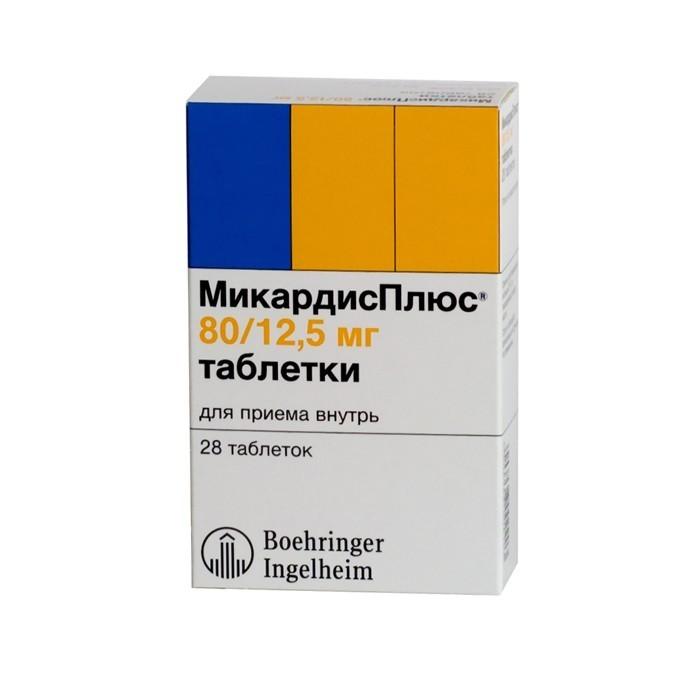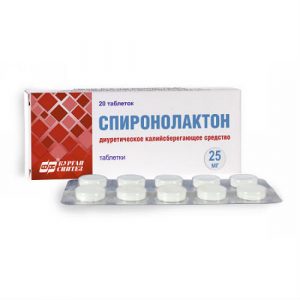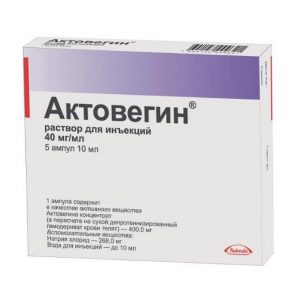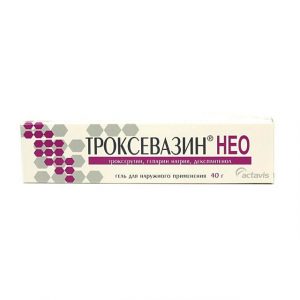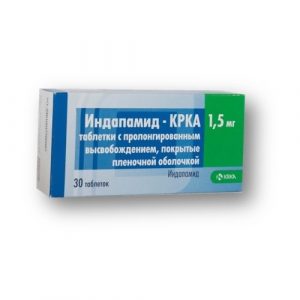Description
Latin name
MicardisPlus
Release form
Tablets.
Packing
28 pcs
Pharmacological action
MIKARDIS PLUS – antihypertensive agent, angiotensin II receptor antagonist (type AT1). It has a very high affinity for this receptor subtype. Selectively and continuously binding to receptors, telmisartan displaces angiotensin II from its association with AT1 receptors. No affinity for other subtypes of AT receptors. The functional significance of other subtypes of receptors and the effect of increased (as a result of the appointment of telmisartan) levels of angiotensin II on them is not known. Telmisartan reduces plasma aldosterone levels, does not inhibit plasma renin, does not block ion channels, does not inhibit ACE (kinase II), which also destroys bradykinin. Therefore, the manifestation of side effects associated with bradykinin is not observed.
Indications
Arterial hypertension.
Contraindications
Obstruction of the biliary tract, severe hepatic and renal impairment, pregnancy, lactation (breastfeeding), hypersensitivity to telmisartan.
Use during pregnancy and lactation
Telmisartan does not have teratogenic effects, but has a fetotoxic effect. Therefore, MikardisPlus should not be used in the first trimester of pregnancy. In the case of a planned pregnancy, MikardisPlus should be replaced with drugs approved for use during pregnancy. If pregnancy is established, you should immediately stop taking the drug.
In the second and third trimesters, the use of the drug can cause electrolyte disturbances in the fetus, as well as, possibly, other disorders that are known in adults. The development of neonatal thrombocytopenia and jaundice (in the fetus or in the newborn) has been reported if the mother has taken thiazide diuretics (including hydrochlorothiazide). Therefore, the drug is contraindicated in the II and III trimester of pregnancy.
It is not yet known whether telmisartan passes into breast milk, hydrochlorothiazide passes into breast milk and can inhibit lactation. Therefore, MikardisPlus is contraindicated for use during lactation.
Composition
1 tablet contains:
Active ingredients:
Telmisartan 80 mg.
Hydrochlorothiazide 12.5 mg.
Excipients:
Povidone, meglumine, sodium hydroxide, sorbitol, magnesium stearate, microcrystalline cellulose, iron oxide red, sodium starch glycolate, lactose monohydrate, corn starch.
Dosage and administration of
For adults, the daily dose is 20-40 mg (1 time / day). In some patients, a hypotensive effect can be achieved at a dose of 20 mg / day. If necessary, the dose can be increased to 80 mg / day.
Patients with impaired renal function, as well as elderly patients, do not need dose adjustment.
For patients with impaired liver function, the daily dose is 40 mg.
Side effects
From the side of the central nervous system: headache, dizziness, fatigue, insomnia, anxiety, depression, convulsions.
From the digestive system: abdominal pain, dyspepsia, nausea, diarrhea, increased activity of hepatic transaminases.
From the respiratory system: cough, pharyngitis, upper respiratory tract infection.
From the hemopoietic system: a decrease in hemoglobin.
Allergic reactions: a rash in an isolated case – angioedema.
From the urinary system: peripheral edema, urinary tract infections, increased uric acid levels, hypercreatininemia.
From the cardiovascular system: marked decrease in blood pressure, palpitations, chest pain.
From the musculoskeletal system: lower back pain, myalgia, arthralgia.
On the part of laboratory parameters: hyperkalemia, anemia, hyperuricemia.
Other: flu-like syndrome.
º °Ñ ÑÑ ² ½ ½ ¾ ² · ° ¸ ¼ ¾ ´ ¹ÑÑ ² ¸
Ñ ¸ ¾ ´ ½ ¾ ²Ñ ¼ ½ ½ ¾ ¼ ¿Ñ ¸ ¼ ½ ½ ¸ ¸ Ñ ° ½Ñ ¸ ³ ¸ ¿ Ñ Ñ ½ · ¸ ² ½ ¼ ¸ ¿Ñ ¿ °Ñ °Ñ ° ¼ ¸ ² ¾ · ¼ ¾ ¶ ½ ¾ ÑÑ ¸ » ½ ¸ ° ½Ñ ¸ ³ ¸ ¿ Ñ Ñ ½ · ¸ ² ½ ¾ ³ ¾ ´ ¹ÑÑ ² ¸Ñ.
Ñ ¸ ¾ ´ ½ ¾ ²Ñ ¼ ½ ½ ¾ ¼ ¿Ñ ¸ ¼ ½ ½ ¸ ¸ Ñ º ° » ¸ ¹Ñ ± Ñ ³ °ÑÑ ¸ ¼ ¸ ´ ¸ÑÑ Ñ ¸ º ° ¼ ¸, ³ ¿ °Ñ ¸ ½ ¾ ¼, ± ¸ ¾ » ¾ ³ ¸Ñ Ñ º ¸ ° ºÑ ¸ ² ½ ¼ ¸ ´ ¾ ± ° ² º ° ¼ ¸, · ° ¼ ½ ¸Ñ »Ñ ¼ ¸ Ñ ¾ » ¸, Ñ ¾ ´ Ñ ¶ °Ñ ¸ ¼ ¸ º ° » ¸ ¹, ² ¾ · ¼ ¾ ¶ ½ ¾ Ñ ° · ² ¸Ñ ¸ ³ ¸ ¿ Ñ º ° » ¸ ¼ ¸ ¸.
Ñ ¸ ¾ ´ ½ ¾ ²Ñ ¼ ½ ½ ¾ ¼ ¿Ñ ¸ ¼ ½ ½ ¸ ¸ Ñ ¿Ñ ¿ °Ñ °Ñ ° ¼ ¸ » ¸Ñ ¸Ñ ² ¾ · ¼ ¾ ¶ ½ ¾ ¿ ¾ ² Ñ ½ ¸ º ¾ ½Ñ ½Ñ Ñ °Ñ ¸ ¸ » ¸Ñ ¸Ñ ² ¿ » ° · ¼ ºÑ ¾ ² ¸.
Ñ ¸ ¾ ´ ½ ¾ ²Ñ ¼ ½ ½ ¾ ¼ ¿Ñ ¸ ¼ ½ ½ ¸ ¸ ² ¾ · ¼ ¾ ¶ ½ ¾ ¿ ¾ ² Ñ ½ ¸ º ¾ ½Ñ ½Ñ Ñ °Ñ ¸ ¸ ´ ¸ ³ ¾ ºÑ ¸ ½ ° ² ¿ » ° · ¼ ºÑ ¾ ² ¸.
Overdose
Symptoms of telmisartan overdose: marked decrease in blood pressure, tachycardia and / or bradycardia.
Hydrochlorothiazide overdose is accompanied by loss of electrolytes (hypokalemia, hypochloremia) and dehydration resulting from massive diuresis. The most common signs and symptoms of hydrochlorothiazide overdose are nausea and drowsiness. Hypokalemia can lead to muscle spasms and / or aggravate cardiac arrhythmias caused by the concomitant use of cardiac glycosides or certain antiarrhythmic drugs.
Treatment: symptomatic and supportive therapy, the nature of which depends on the time elapsed since taking the drug and the severity of the symptoms. It is recommended to induce vomiting and / or gastric lavage, to appoint activated charcoal. Frequent control of serum electrolytes and creatinine is required. In the case of hypotension, the patient should be placed on his back and a rapid therapy aimed at replacing electrolytes and BCC. Telmisartan is not removed by hemodialysis. The degree of removal of hydrochlorothiazide during hemodialysis has not been established.
Storage conditions
The drug should be stored in a place protected from moisture at a temperature not exceeding 25 ° C.
Expiration
3 years.
Active ingredient
Tafluprost Hydrohlorotyazyd
Dosage form
dosage form
tablets
Beringer Ingelyhaym, Austria
